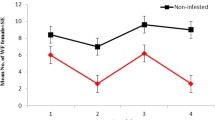Abstract
Pea (Acyrthosiphon pisum Harris) and blue alfalfa aphid (A. kondoi Shinji) deterrency in alfalfa (Medicago saliva L.) may result from incorporating higher levels of the aphid alarm pheromone,(E)-β-farnesene relative to(E)-β-caryophyllene. We evaluated five eglandular and two glandular-haired alfalfa accessions for differences in(E)-β-farnesene and(E)-β-caryophyllene content under glasshouse conditions using supercritical fluid extraction and gas chromatography. In addition, pea and blue alfalfa aphid olfactory behavioral tests were conducted uponMedicago species containing different ratios of(E)-β-famesene relative to(E)-β-caryophyllene. No differences in(E)-β-caryophyllene content were observed among the seven entries (μ=0.42 ng/g plant material). Significant differences (P ≤ 0.05) among entries were observed for(E)-β-famesene content, with KS94GH6 exhibiting the highest (1.18 ng/g), and CUF 101 the lowest levels (0.35 ng/g). Elite tetraploid sources possessed significantly lower levels (μ=0.42 ng/g) of(E)-β-farnesene than did wild and cultivated diploid accessions (μ=0.83 ng/g). Olfactory behavioral tests for both the pea and blue alfalfa aphids demonstrated KS94GH6 repelled aphids while cultivated alfalfa types attracted aphids in each case. Previously demonstrated aphid resistance in diploid KS94GH6 may result from superior(E)-β- farnesene levels, but(E)-β-farnesene is probably not a factor in cultivated alfalfa resistance. Finally, accession KS94GH6 could act as an excellent germplasm resource for the incorporation of higher(E)-β-farnesene levels into cultivated alfalfa.
Similar content being viewed by others
References
Brewer, G. J., Sorensen, E. L., andHorber, E. K. 1983. Attractiveness of glandular and simple-hairedMedicago clones with different degrees of resistance to the alfalfa seed chalcid (Hymenoptera: Eurytomidae) tested in an olfactometer.Environ. Entomol. 12:1504–1508.
Buttery, R. G., Kamm, J. A., andLing, L. C. 1982. Volatile components of alfalfa flowers and pods.J. Auric. Food Chem. 30:739–742.
Core, R. J., Henning, J. A., andGardea-Torresdey, J. 1994. Volatile compounds fromMedicago spp. as potential signals for alfalfa weevil response.J. Agric. Food Chem. 42:2932–2936.
Dawson G. W., Griffiths, D. C., Pickett, J. A., Smith, M. C., andWoodcock, C. M. 1984. Natural inhibition of the aphid alarm pheromone.Entomol. Exp. App. 36:197–199.
Ferguson, S., Sorensen, E. L., andHorber, E. K. 1982. Resistance to the spotted alfalfa aphid (Homoptera: Aphididae) in glandular-hairedMedicago species.Environ. Entomol. 11:1229–1232.
Gibson, R. W., andPickett, J. A. 1983. Wild potato repels aphids by release of aphid alarm pheromone.Nature 302:608–609.
Henning, J. A., Core, R. J., andGardea-Torresdey, 1994. Extracting volatile and semi-volatile compounds from single plants using supercritical fluid extraction.Crop Sci. 34:1120–1122.
Manglitz, G. R., andRatcliffe, R. H. 1988. Insects and mites, pp. 671–704,in A. A.Hanson, D. K.Barnes, and R. R.Hill (eds.). Alfalfa and Alfalfa Improvement. American Society of Agronomy, Monograph No. 29.
Montgomery, M. E., andNault L. R. 1978. Effects of age and using polymorphism on the sensitivity ofMyzus persicae to alarm pheromone.Ann. Entomol. Soc. Am. 71:788–790.
Nault, L. R., Edwards, L. J., andStyer, W. E. 1973. Aphid alarm pheromone: Secretion and reception.Environ. Entomol. 2:101–105.
Nielson M. W., Schanhurst M. H., Don, H., Lehman, W. F., andMarble V. L. 1971. Resistance in alfalfa to four biotypes of the spotted alfalfa aphid.J. Econ. Entomol. 65:506–510.
Pickett, J. A., andGriffiths D. C. 1980. The composition of aphid alarm pheromones.J. Chem. Ecol. 6:349–360.
Snedecor, G. W., andCochran, W. G. 1980. Statistical Methods, 7th ed. Iowa State University Press, Ames.
Sorensen, E. L., Harber, E. K., andStuteville, D. L. 1985. Registration of KS108GH5 glandular-haired alfalfa germplasm with multiple pest resistance.Crop Sci. 25:1132.
Sorensen, E. L., Harber, E. K., andStuteville, D. L. 1986. Registration of KS94GH6 glandular-haired germplasm with multiple pest resistance.Crop Sci. 26:1088.
Townsend, M. S., Henning, J. A., andCurrier, C. G., 1994. The alfalfa catalog software package.Agron. J. 86:337–339.
Author information
Authors and Affiliations
Additional information
Research supported by the New Mexico State University Agricultural Experiment Station.
Rights and permissions
About this article
Cite this article
Mostafavi, R., Henning, J.A., Gardea-Torresday, J. et al. Variation in aphid alarm pheromone content among glandular and eglandular-hairedMedicago accessions. J Chem Ecol 22, 1629–1638 (1996). https://doi.org/10.1007/BF02272403
Received:
Accepted:
Issue Date:
DOI: https://doi.org/10.1007/BF02272403




